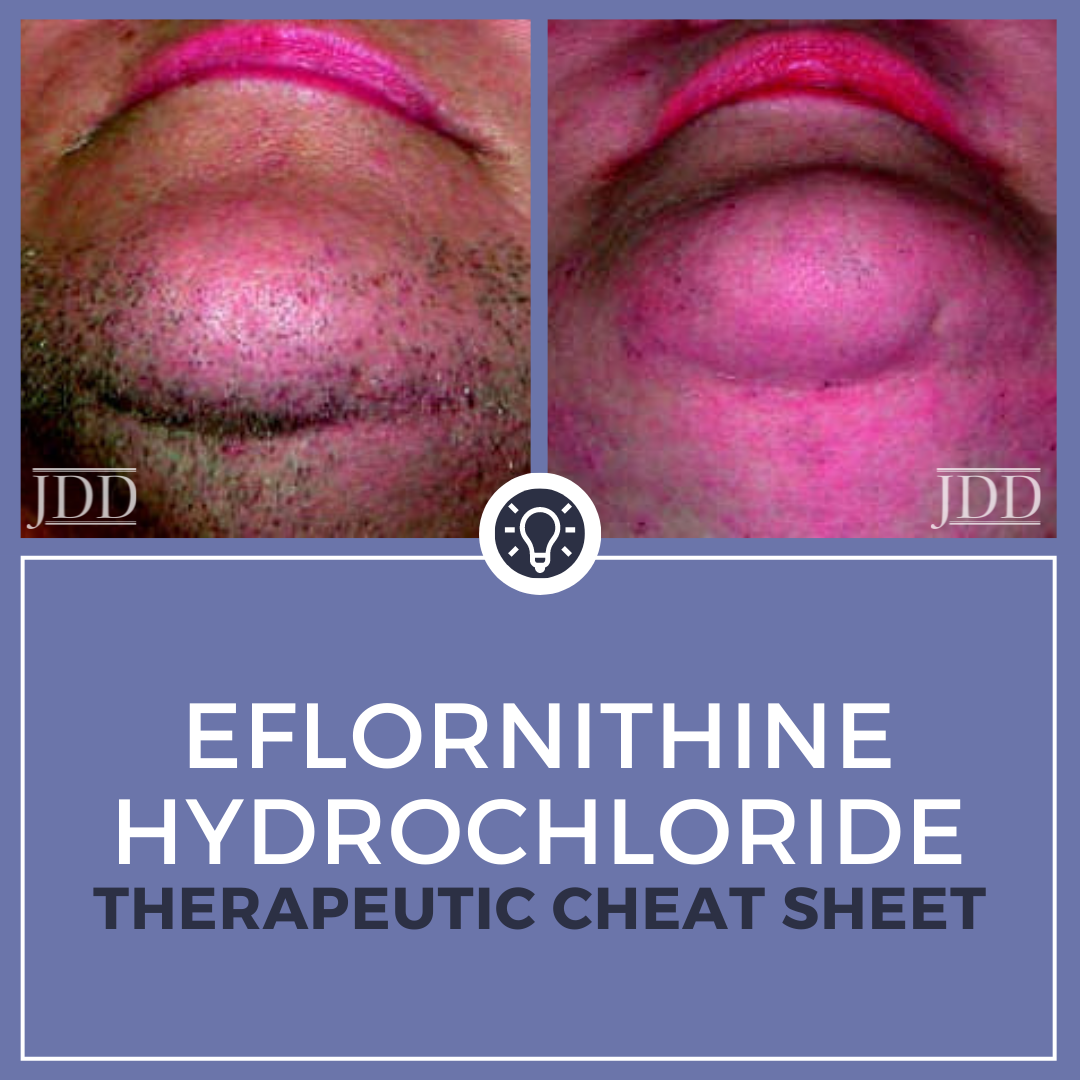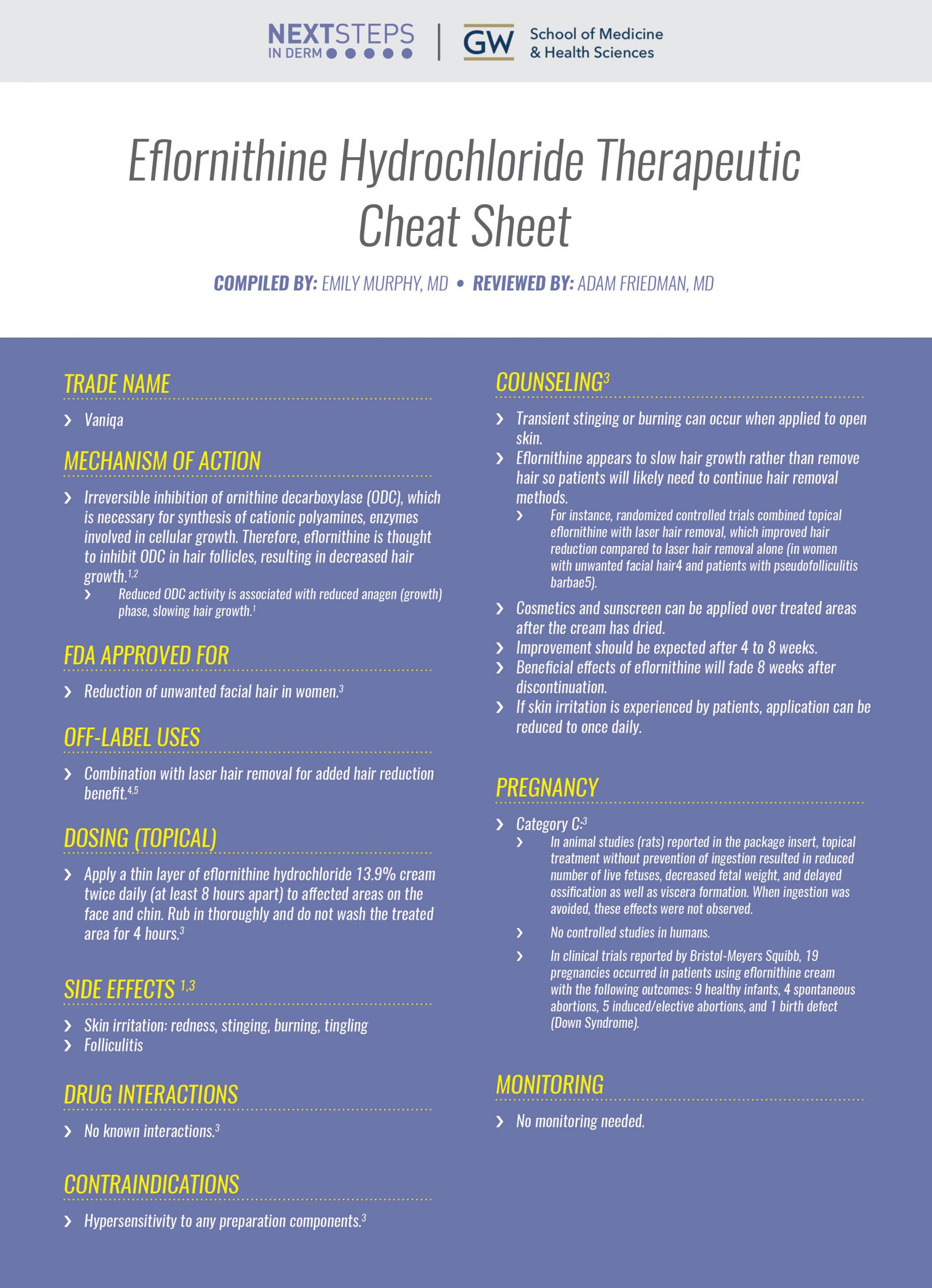Millions of patients experience unwanted facial hair, severely impacting their quality of life. Laser hair removal is often the treatment of choice, but this therapy is uncomfortable, requires multiple treatments, and risks pigmentary changes. Therefore, an effective topical therapy for reduction of unwanted hair is a valuable addition to our therapeutic repertoire. We continue our series, Therapeutic Cheat Sheet, with a closer look at eflornithine, a topical therapy that decreases hair growth. Eflornithine is FDA-approved for reduction of unwanted facial hair in women and has also been combined with laser hair removal for additive hair reduction effects in clinical trials.
EFLORNITHINE HYDROCHLORIDE THERAPEUTIC CHEAT SHEET
Compiled by: Emily Murphy, MD, Reviewed by: Adam Friedman, MD
TRADE NAME
-
- Vaniqa
MECHANISM OF ACTION
-
- Irreversible inhibition of ornithine decarboxylase (ODC), which is necessary for synthesis of cationic polyamines, enzymes involved in cellular growth. Therefore, eflornithine is thought to inhibit ODC in hair follicles, resulting in decreased hair growth.1,2
- Reduced ODC activity is associated with reduced anagen (growth) phase, slowing hair growth.1
- Irreversible inhibition of ornithine decarboxylase (ODC), which is necessary for synthesis of cationic polyamines, enzymes involved in cellular growth. Therefore, eflornithine is thought to inhibit ODC in hair follicles, resulting in decreased hair growth.1,2
FDA APPROVED FOR
-
- Reduction of unwanted facial hair in women.3
OFF-LABEL USES
-
- Combination with laser hair removal for added hair reduction benefit.4,5
DOSING (TOPICAL)
-
- Apply a thin layer of eflornithine hydrochloride 13.9% cream twice daily (at least 8 hours apart) to affected areas on the face and chin. Rub in thoroughly and do not wash the treated area for 4 hours.3
SIDE EFFECTS1,3
-
- Skin irritation: redness, stinging, burning, tingling
- Folliculitis
DRUG INTERACTIONS
-
- No known interactions.3
CONTRAINDICATIONS
-
- Hypersensitivity to any preparation components.3
COUNSELING3
-
- Transient stinging or burning can occur when applied to open skin.
- Eflornithine appears to slow hair growth rather than remove hair so patients will likely need to continue hair removal methods.
- For instance, randomized controlled trials combined topical eflornithine with laser hair removal, which improved hair reduction compared to laser hair removal alone (in women with unwanted facial hair4 and patients with pseudofolliculitis barbae5).
- Cosmetics and sunscreen can be applied over treated areas after the cream has dried.
- Improvement should be expected after 4 to 8 weeks.
- Beneficial effects of eflornithine will fade 8 weeks after discontinuation.
- If skin irritation is experienced by patients, application can be reduced to once daily.
PREGNANCY
-
- Category C:3
- In animal studies (rats) reported in the package insert, topical treatment without prevention of ingestion resulted in reduced number of live fetuses, decreased fetal weight, and delayed ossification as well as viscera formation. When ingestion was avoided, these effects were not observed.
- No controlled studies in humans.
- In clinical trials reported by Bristol-Meyers Squibb, 19 pregnancies occurred in patients using eflornithine cream with the following outcomes: 9 healthy infants, 4 spontaneous abortions, 5 induced/elective abortions, and 1 birth defect (Down Syndrome).
- Category C:3
MONITORING
-
- No monitoring needed.
SUMMARY
For patients hoping to slow unwanted hair growth, including patients with pseudofolliculitis barbae, it is important to consider the topical therapy, eflornithine. This cream can also be used to supplement the effects of laser hair removal. It is important to counsel patients on the time course of this medication, including that it takes 4 to 8 weeks to see results and that the beneficial effects will dissipate 8 weeks after discontinuation. This topical therapy is safe, with only skin irritation and folliculitis as possible side effects, so it is an important medication for our armamentarium.
CLICK ON THE IMAGE BELOW TO ENLARGE AND/OR DOWNLOAD YOUR THERAPEUTIC CHEAT SHEET
FURTHER READING
If you would like to learn more about thalidomide, check out the following articles published in the Journal of Drugs in Dermatology:
Laura Ganger MD and Iltefat Hamzavi MD
Abstract:
A common problem among aging women, salt and pepper facial hair poses a significant psychosocial impact as well as a challenge for treatment. Various laser therapies or topical eflornithine HCl 13.9% cream are commonly used to reduce the rate of hair growth. We report a case of a woman with salt and pepper hair in the beard distribution. A combination of laser hair removal with concurrent use of topical eflornithine was used in the treatment.
J Drugs Dermatol. 2006;5(6):544.
Hair and Scalp Disorders in Ethnic Populations
Ife Rodney MD, Oge Onwudiwe MD, Valerie Callender MD, and Rebat Halder MD
Abstract:
Human hair has been classified into 3 major groups, as determined by ethnic origin. In these populations, significant structural and biochemical variations of the hair follicle and shaft are seen, as well as unique hair grooming practices. These structural variations of the hair are closely linked to the common disorders of the hair and scalp, such as acquired trichorrhexis nodosa, seborrheic dermatitis, traction alopecia, central centrifugal cicatricial alopecia, dissecting cellulitis, frontal fibrosing alopecia, and pseudofolliculitis barbae.
J Drugs Dermatol. 2013;12(4):420-427.
Pseudofolliculitis Barbae: A Review of Current Treatment Options
Dillon Nussbaum BS and Adam Friedman MD
Abstract:
The purpose of this review is to discuss the disease process and wide variety of treatment options for psuedofolliculitis barbae (PFB), or razor bumps. PFB is caused by hair follicles penetrating the skin and causing an inflammatory response. PFB can occur to anyone who shaves, and is more likely in those with curly hair. PFB can cause significant hyperpigmentation and scarring, more noticeable in darker skin types. PFB can be treated with a variety of topical, systemic, or light/laser therapies. Minimal progress has been made in treating PFB in recent years, partially due to the success of well-established current treatments discussed in this review. The most effective treatments involve a multifaceted approach including behavioral changes in shaving habits as well as the use of topical therapies.
J Drugs Dermatol. 2019;18(3):246-250.
References
-
- Shapiro J, Lui H. Vaniqa–eflornithine 13.9% cream. Skin Therapy Lett. 2001;6(7):1-3, 5.
- Balfour JA, McClellan K. Topical eflornithine. Am J Clin Dermatol. 2001;2(3):197-201; discussion 202. doi:10.2165/00128071-200102030-00009
- Bristol-Myers Squibb Labeling. Vaniqa Package Insert. Published online July 27, 2000.
- Hamzavi I, Tan E, Shapiro J, Lui H. A randomized bilateral vehicle-controlled study of eflornithine cream combined with laser treatment versus laser treatment alone for facial hirsutism in women. J Am Acad Dermatol. 2007;57(1):54-59. doi:10.1016/j.jaad.2006.09.025
- Xia Y, Cho S, Howard RS, Maggio KL. Topical eflornithine hydrochloride improves the effectiveness of standard laser hair removal for treating pseudofolliculitis barbae: a randomized, double-blinded, placebo-controlled trial. J Am Acad Dermatol. 2012;67(4):694-699. doi:10.1016/j.jaad.2011.10.029
Did you enjoy this Therapeutic Cheat Sheet? You can find more here.


